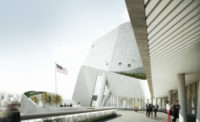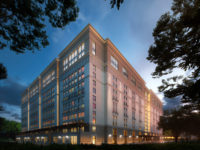
In Fire Island Pines, the storied gay resort town 50 miles from Manhattan, the talk last weekend—somewhat surprisingly—was about architecture. At Whyte Hall, a community center designed by architect Scott Bromley (who got his start creating sets for Studio 54), Christopher Rawlins signed copies of his book about Horace Gifford, the designer of dozens of houses in the Pines in the 1960s and 70s. As Rawlins proves in his book, Fire Island Modernist, Gifford’s houses, though deferential to their natural surroundings, are based on serious architectural ideas derived, in part, from Louis Kahn, with whom Gifford studied at the University of Pennsylvania. The floor plans of some of Gifford’s houses, reproduced in the book, make dazzling use of Kahn’s concept of “served” and “servant” spaces.
 |
| HWKN's Fire Island Pines Pavilion. |
At the same time, the Pines Pavilion, the disco designed by Manhattan’s HWKN, was opening, and everyone had an opinion. Replacing a forgettable building that burned down in the fall of 2011, the new Pines Pavilion is, like the best Gifford houses, a piece of serious architecture in an informal setting. Indeed, it could be seen as the love child of Gifford and OMA, where Matthias Hollwich worked for four years before forming HWKN with partner Marc Kushner. Like Gifford’s buildings, it is sheathed in wood. Like OMA’s, it is a strong geometric presence, angular and asymmetrical, with a gigantic truss system.
Inside the pavilion, a maze-like ground floor contains office spaces, a “welcome bar,” rest rooms, and other support services. The second floor is divided between a “party terrace” and the sanctum sanctorum: the disco. As the room filled up at 1 a.m. on opening night, the sound system and lights created much of the excitement, but a number of people commented on the architecture itself. More than one observer compared the space to Studio 54. That’s because HWKN included risers at both ends of the room, stepped perches on which the best dancers could strut their stuff while spectators could look down on the crowd below. (At Studio 54, the chance to look down on the dance floor from the balcony was crucial to the “everyone can be a star” experience.)
Heightening the drama, the long, trapezoidal room narrows from about 10 feet wide at one end to about 35 feet wide at the other, suggesting exclusivity and possibility. The bleachers at the narrow, north end lead to a large rectangular window, creating an effect many compared to the “square” where Manhattan’s High Line crosses 10th Avenue, at 17th Street, and visitors can observe the traffic passing underneath. (Charles Renfro, of High Line architects Diller Scofidio + Renfro, was an informal advisor to HWKN on the Pines Pavilion.) Even more surprising, a large square opening in the ceiling over the dance floor, its black frame invisible at night, is as compelling as a James Turrell “Skyspace.” Serious architecture or not, Hollwich insists the building was designed “not for architectural insiders, but for the community.” And so far, the community is smitten.


